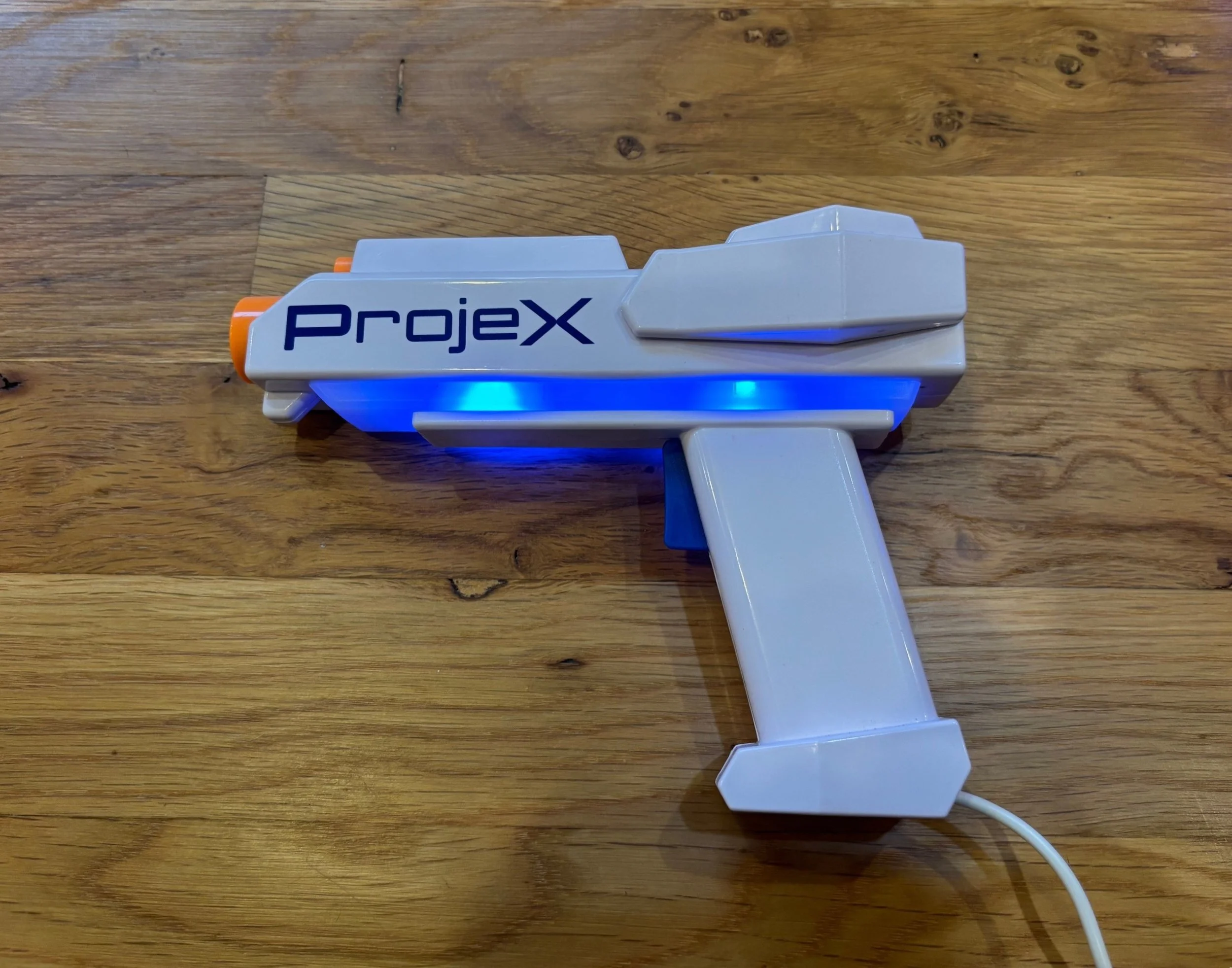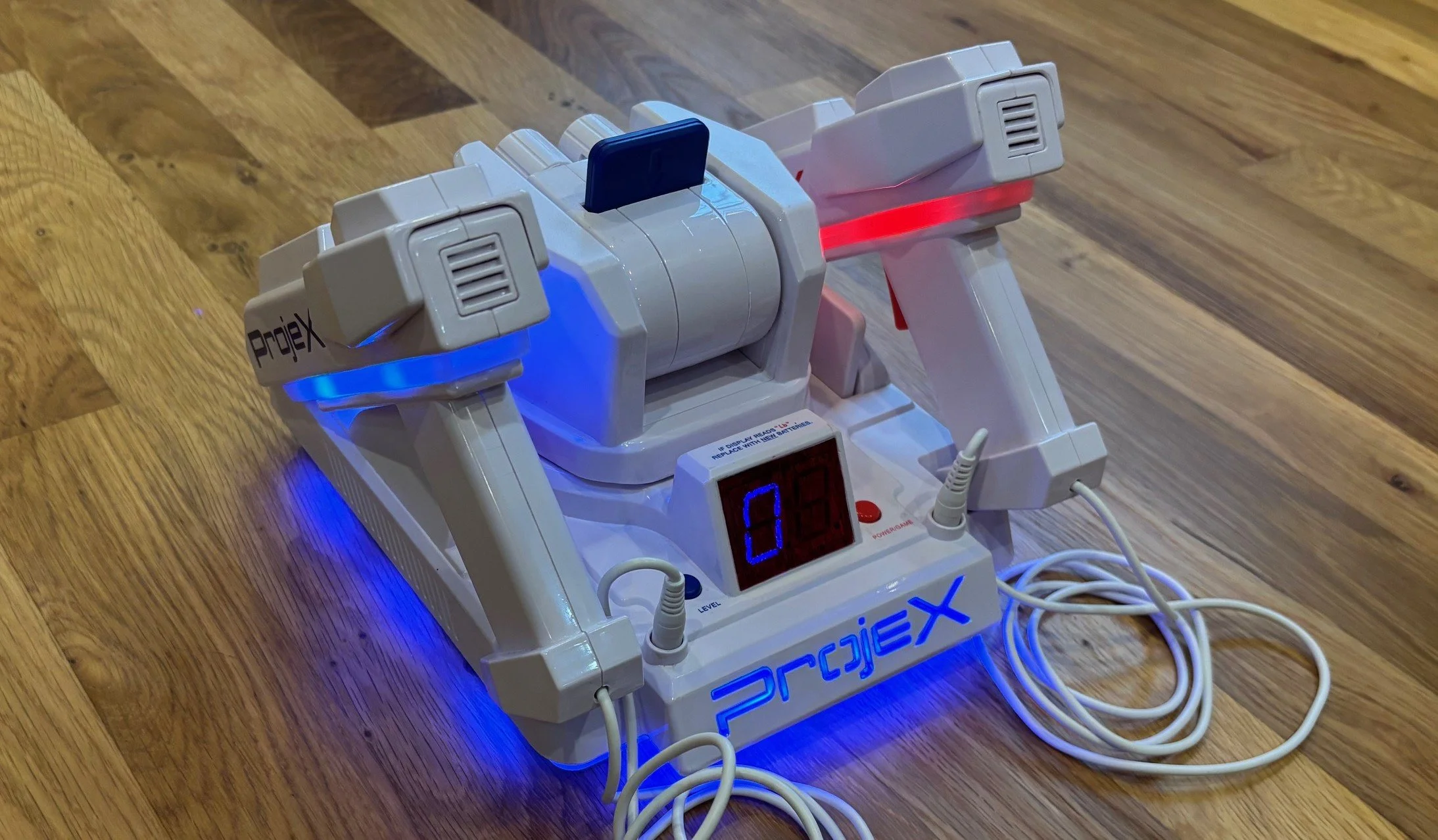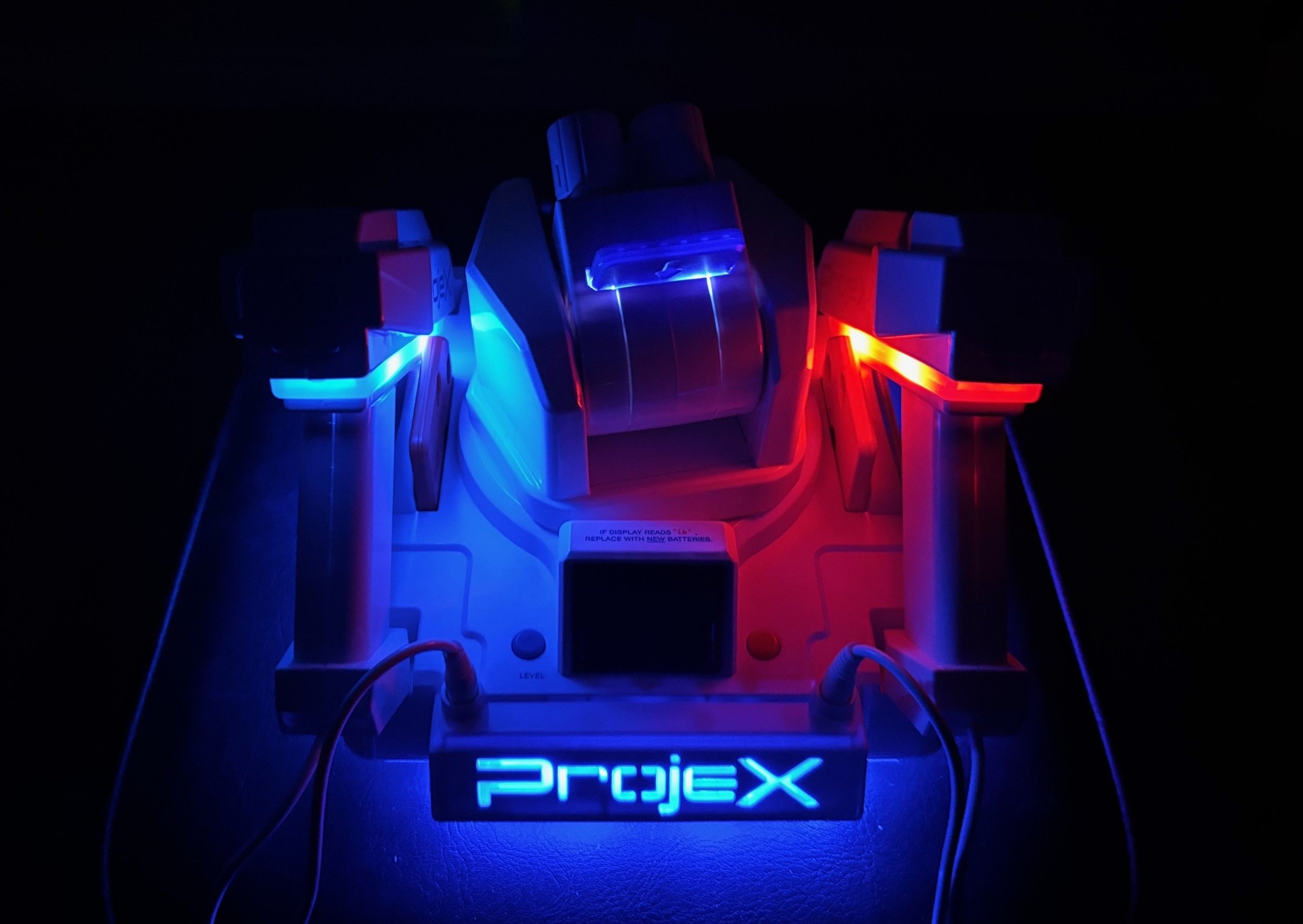Review: ProjeX Projection Arcade Game & Clones
Originally released in the Holiday season of 2019, the ProjeX Projection Arcade Game system is miraculously still on sale today, six years later, which is pretty rare for this type of product. The other rare thing is it’s still available on brick & mortar store shelves and from major retailers like Target, Barnes & Noble, in addition to the official ProjeX website.
It’s made by the same company as the Laser X laser tag system, but obviously plays differently, since you’re not shooting at other people. The guns track the light of the projector to register a hit (similar to older CRT light guns,) with some very simple and low-cost technology that aims to replicate old-school projection light gun shooting gallery games.
Home projection light gun games are nothing new, as they’ve been around since the early 1970s, including one notable system from 1976, when Nintendo released their own Duck Hunt projection game eight years before the NES version we all know and love was released. This type of projection gun system has come in and out of popularity in various forms a number of times over the years, but still manages to keep coming back, somehow or another.
Though the ProjeX system has had a few very minor changes in shape/appearance since it’s original release, the newer units still function the same as the old ones, with the exception of the one odd version that only has one gun and doesn’t contain the game cards, with only has one target type, called ProjeX Duck Arcade, which was only sold in certain markets for a short time.
As for the aesthetics and build of the unit, it’s fairly simple and feels relatively cheap, but the aesthetics are nice overall. The LED lights really make the aesthetics shine when you’re playing in the dark, and it looks pretty sleek. The guns simply have a trigger and a reload slide on the top, and the main unit has either 2 or 3 lenses on the front that project the game, and they’re attached to a swiveling head that rotates in all directions.
The guns also both have (simulated) laser pointers on them, so you can keep track of your aiming in the dark (or entertain your cats!) which is a nice touch that gives you a relative sense of where you’re aiming. However, the accuracy of the laser isn’t exactly what you might expect, and it may not always be perfect every time, but for a cheap little box that runs on a few AA batteries, this is a decent piece of hardware.
ProjeX is advertised as being very versatile and “play wherever you want” with no TV required, and it mostly delivers on that promise. The manual gives fairly specific setup instructions as far as the height off the ground and how far away the unit should be from the surface you want to play on, and I’ve found it needs to be fairly accurate to those instructions for the tracking to work well. Though, I found that putting the unit closer to the surface than what the instructions recommend tends to be slightly more accurate, but also can make the game a little too easy if it’s too close. It needs to be on a flat, light-colored wall or screen with no art or pictures on it, which means it can also be used outdoors if you have the space for it, so you’ll have to calibrate and get it right for your own setup/environment.
It can be played with 1 player or 2 players (you just uplug the second gun for 1-player,) and has 3 different game cards, which have 5 different games each, and feature 3 difficulty levels each. Any of the games can be played either in single-player, two-player competitive, or two-player co-op modes, and this makes for a pretty good amount of content included in the package, especially for the relatively low price these can usually be found for.
There’s a few issues with tracking that can get a little annoying, and even when the unit is calibrated to the best of its ability, you’ll get some missed shots on occasion, and even more missed shots if you’re not in a very dark environment. Bright light sources within 10-20 feet of the unit can disrupt the guns’ tracking and cause some missed shots, so it’s a caveat of being able to play it well, and even in optimal conditions, the accuracy is usually only around 80-85% on average.
The instructions also mention to shoot each target several times to make sure you get a hit, making it seem it was fairly known that the tracking wasn’t perfect when the unit was developed, so it’s just a part of the package when you buy into it. Speaking of the instructions, you’ll probably want to keep them nearby and read them carefully when figuring out how to operate the system, since it’s not very intuitive at all based on the primitive buttons and screen on the unit.
For light gun enthusiasts, your mileage will vary, and also depend on how many friends you have who are willing to play the two-player modes with you, especially since most of the game cards don’t vary from each other that much overall. The randomness of the patterns still makes for a decent amount of play time to be had, but at its most complex, the games included here don’t get much more complex than the NES version of Duck Hunt, for instance.
The fact that there’s a product like this that’s still being sold in 2025 is a surprise in itself, since it calls back to a bygone era of home light gun entertainment in it’s own way, so it’s nice that it’s still around. On that note, I don’t know that most younger children nowadays would get much enjoyment out of this past a few minutes, since now most of them are accustomed to the constant dopamine rush of modern shooter video games, but it might be worth a shot.
As for final thoughts, despite leaning fairly hard into the “novelty” category overall, this unit can still give you some enjoyment and is also keeping a certain old style of entertainment and technology alive in a way that’s hard not to appreciate for those of us who lived through the era where these kinds of projector gun systems were more prevalent. If you happen to see one on a store shelf this year (or in a thrift store/eBay..) it might be worth your time, depending on the price.
Score: 7/10
Clone Systems:
There’s also a variety of clone systems out there that generally replicate very closely what the ProjeX system does, and it’s been re-packaged many times with different brand names on the listing and slightly different guns, but the functionality and technology of them is all the same. I got hands-on with two of them in particular to review, but these comments will apply to all of them, even if the gun shells are slightly different.
The systems all end up costing different amounts, and they’re all generally a little bit more expensive than what the ProjeX costs, but they feature wireless guns that can also be used as actual laser tag guns, even without extra vests or sensors (the guns act as the sensors.) However, most packages that include the projector light gun game don’t include separate laser tag sensors with them (except this one.) The guns work quite well, generally edging out the ProjeX guns in accuracy most of the time, and them being wireless is nice, but it also requires some extra batteries for the guns (except for this one and this one, which have rechargeable guns.)
The downside of these units is that while they do have three game cards, like the ProjeX does, there’s only two modes playable for each card, which adds up to a lot less gameplay variety than the ProjeX machine has. Both modes can be played solo, co-op, or competitive multiplayer, but there’s a lot less options and variety as far as the types of gameplay you can have.
Other than having less projector gameplay options available, these clone systems function mostly the same as the ProjeX, with the one other exception that they also support 4 players, which the ProjeX does not. The caveat is that most of the listings to buy these only come with two guns, so you’d have to track down and buy more compatible guns to play with four people.
The instructions and functionality to get them working is just about as obtuse as the ProjeX, with an extra step that you also need to change the guns from “laser tag” mode to “projector” mode in order to use them with the projector, but at least with these devices, there’s a voice prompt that gives you an idea of what you’re doing, instead of having to fully rely on the manual to get started.
The first stage-based game mode runs you through 10 escalating levels of difficulty with randomly placed targets and a game over if you miss a certain amount, where the second game mode projects 50 targets in quick succession and counts who got the most targets at the end.
Overall, these are quite fun, but since they’re a little more expensive than the ProjeX, it’s hard to say which one is more worth getting, but if you really need wireless guns, laser tag functionality or 4 player support, these might be your way to go. With just a little less value overall in the projector gameplay, but higher accuracy and functionality overall, it makes it a close call with the ProjeX, but these clones are still a fun option for modern projector light gun play.










